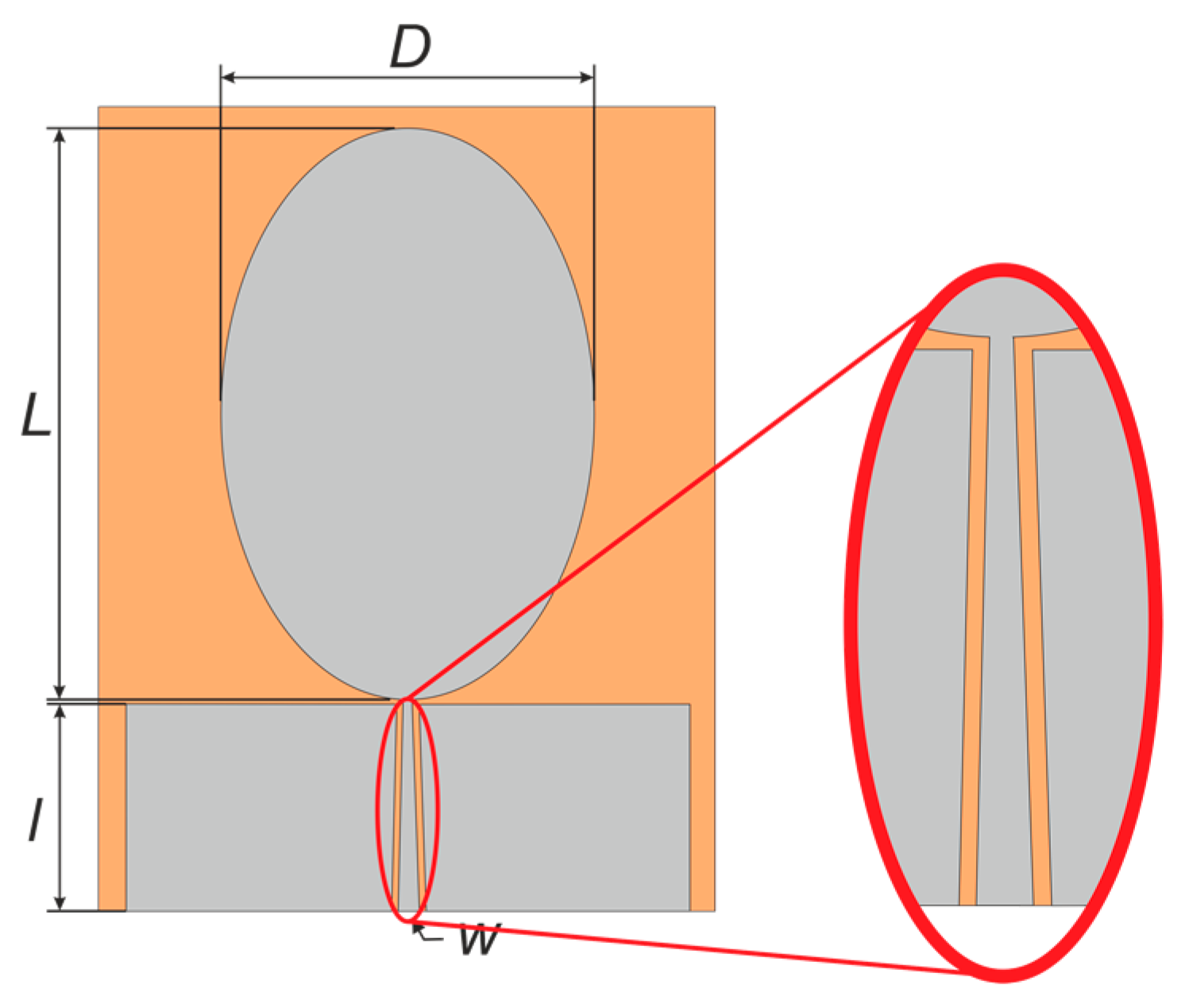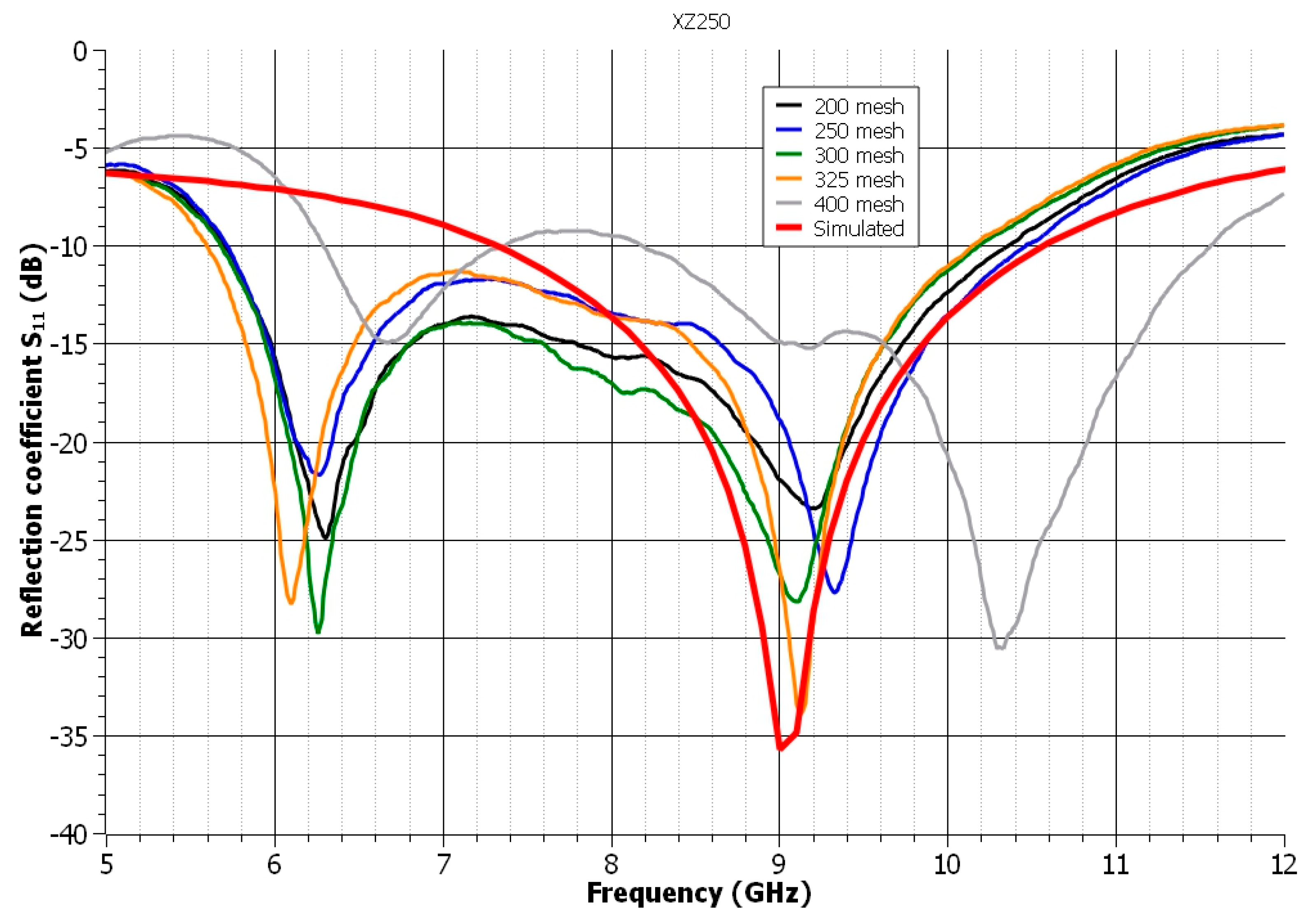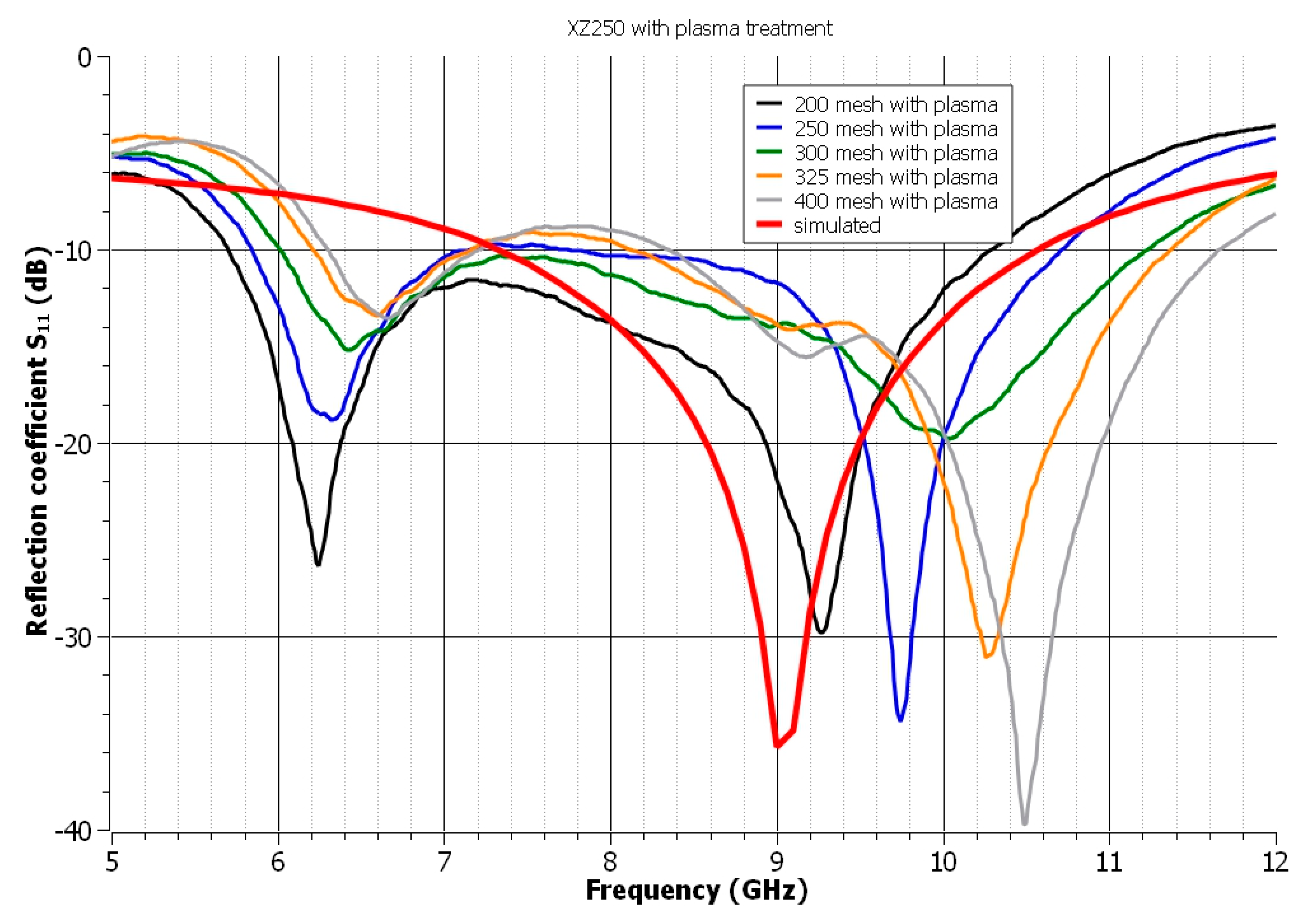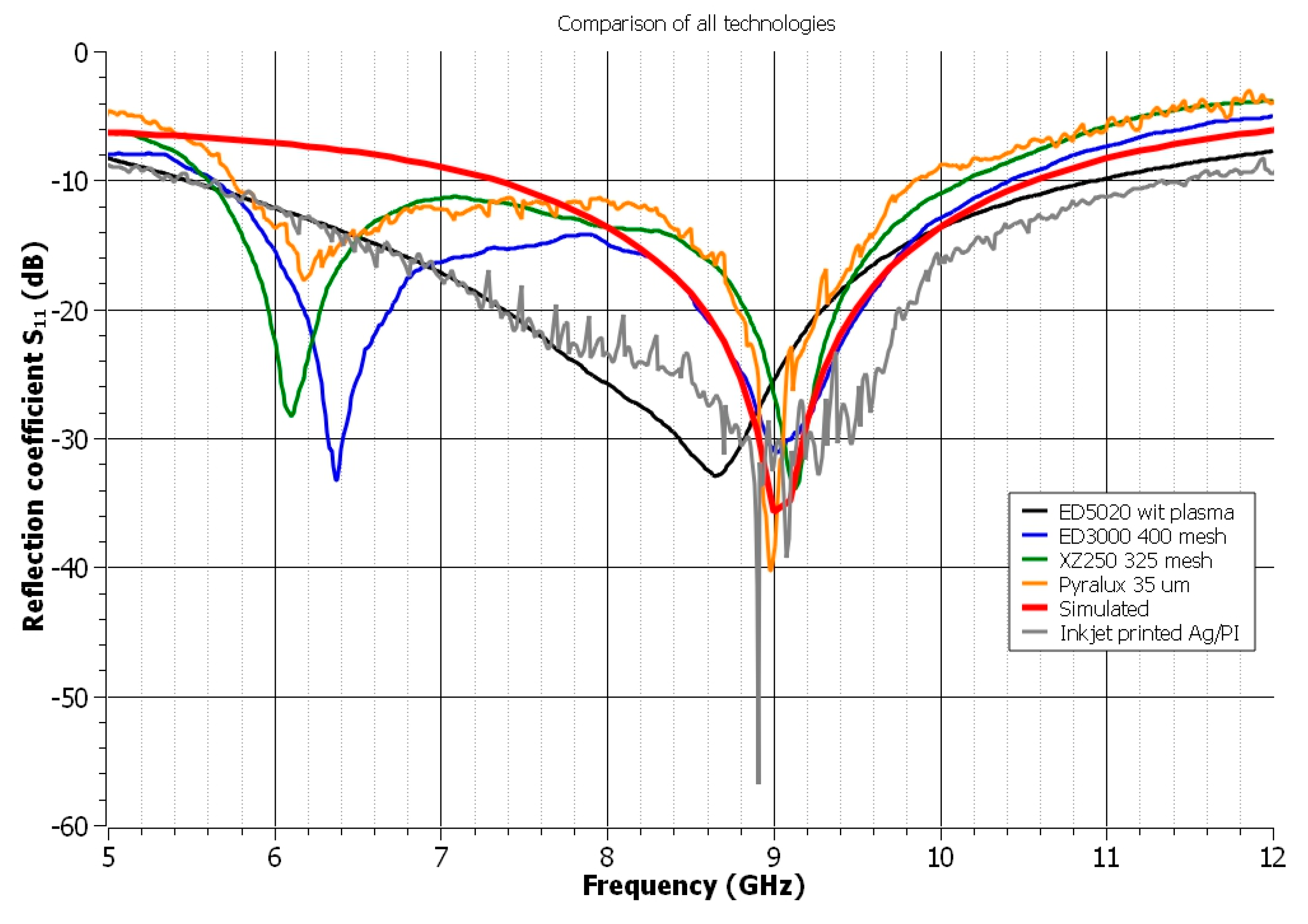Influence of Various Technologies on the Quality of Ultra-Wideband Antenna on a Polymeric Substrate
Abstract
1. Introduction
2. Materials and Methods
2.1. Antenna Design
2.2. Samples Preparation
3. Results and Discussion
4. Conclusions
Author Contributions
Funding
Institutional Review Board Statement
Informed Consent Statement
Data Availability Statement
Conflicts of Interest
References
- Federal Communications Commission. Revision of Part 15 of the Commission’s Rules Regarding Ultra WideBand Transmission Systems; Federal Communications Commission: Washington, DC, USA, 2002.
- Thakare, R.; Kulat, K.; Chede, S. Overview and Analysis of UWB Signal for Low Power WPAN. Int. J. Comput. Appl. 2010, 1, 6–10. [Google Scholar] [CrossRef]
- Alani, S.; Zakaria, Z.; Saeidi, T.; Ahmad, A.; Mahmood, S.N.; Saad, M.A.; Rashid, S.A.; Hamdi, M.M.; Albeyar, M.A.A.A. A Review on UWB Antenna Sensor for Wireless Body Area Networks. In Proceedings of the 2020 4th International Symposium on Multidisciplinary Studies and Innovative Technologies (ISMSIT), IEEE, Istanbul, Turkey, 22 October 2020; pp. 1–10. [Google Scholar]
- Ray, K.P. Design Aspects of Printed Monopole Antennas for Ultra-Wide Band Applications. Int. J. Antennas Propag. 2008, 2008, 1–8. [Google Scholar] [CrossRef]
- Dwivedi, R.P.; Kommuri, U.K. Compact High Gain UWB Antenna Using Fractal Geometry and UWB-AMC. Microw. Opt. Technol. Lett. 2019, 61, 787–793. [Google Scholar] [CrossRef]
- Nemati, N.; Bemani, M. A Novel Reconfigurable Microstrip Fractal UWB Antenna with Six Variable Rejection Frequency Bands. Int. J. Microw. Wirel. Technol. 2020, 12, 148–154. [Google Scholar] [CrossRef]
- Gopi, D.; Vadaboyina, A.R.; Dabbakuti, J.R.K.K. DGS Based Monopole Circular-Shaped Patch Antenna for UWB Applications. SN Appl. Sci. 2021, 3, 198. [Google Scholar] [CrossRef]
- Awan, W.A.; Zaidi, A.; Hussain, M.; Hussain, N.; Syed, I. The Design of a Wideband Antenna with Notching Characteristics for Small Devices Using a Genetic Algorithm. Mathematics 2021, 9, 2113. [Google Scholar] [CrossRef]
- Boursianis, A.D.; Papadopoulou, M.S.; Salucci, M.; Polo, A.; Sarigiannidis, P.; Psannis, K.; Mirjalili, S.; Koulouridis, S.; Goudos, S.K. Emerging Swarm Intelligence Algorithms and Their Applications in Antenna Design: The GWO, WOA, and SSA Optimizers. Appl. Sci. 2021, 11, 8330. [Google Scholar] [CrossRef]
- Godlinski, D.; Zichner, R.; Zöllmer, V.; Baumann, R.R. Printing Technologies for the Manufacturing of Passive Microwave Components: Antennas. IET Microw. Antennas Propag. 2017, 11, 2010–2015. [Google Scholar] [CrossRef]
- Lamminen, A.; Arapov, K.; de With, G.; Haque, S.; Sandberg, H.G.O.; Friedrich, H.; Ermolov, V. Graphene-Flakes Printed Wideband Elliptical Dipole Antenna for Low-Cost Wireless Communications Applications. IEEE Antennas Wirel. Propag. Lett. 2017, 16, 1883–1886. [Google Scholar] [CrossRef]
- Abutarboush, H.F.; Li, W.; Shamim, A. Flexible-Screen-Printed Antenna with Enhanced Bandwidth by Employing Defected Ground Structure. IEEE Antennas Wirel. Propag. Lett. 2020, 19, 1803–1807. [Google Scholar] [CrossRef]
- Shaker, G.; Safavi-Naeini, S.; Sangary, N.; Tentzeris, M.M. Inkjet Printing of Ultrawideband (UWB) Antennas on Paper-Based Substrates. IEEE Antennas Wirel. Propag. Lett. 2011, 10, 111–114. [Google Scholar] [CrossRef]
- Lukacs, P.; Pietrikova, A.; Potencki, J.; Tomaszewski, G. UWB Antenna Based on Nanoparticles of Silver on Polyimide Substrate. In Proceedings of the International Spring Seminar on Electronics Technology, IEEE Computer Society, Eger, Hungary, 6-10 May 2015; Volume 2015, pp. 408–413. [Google Scholar]
- Ibanez-Labiano, I.; Nourinovin, S.; Alomainy, A. Graphene Inkjet-Printed Ultrawideband Tapered Coplanar-Waveguide Antenna on Kapton Substrate. In Proceedings of the 2021 15th European Conference on Antennas and Propagation (EuCAP), IEEE, Dusseldorf, Germany, 22 March 2021; pp. 1–4. [Google Scholar]
- Farooq, U.; Iftikhar, A.; Fida, A.; Shafique, M.F.; Asif, S.M.; Braaten, B.D. UWB Antenna Printing on Glass Substrate Through Cost-Effective Copper Foils. In Proceedings of the 2019 IEEE International Symposium on Antennas and Propagation and USNC-URSI Radio Science Meeting, IEEE, Atlanta, GA, USA, 7–12 July 2019; pp. 1741–1742. [Google Scholar]
- Roshni, S.B.; Jayakrishnan, M.P.; Mohanan, P.; Surendran, K.P. Design and Fabrication of an E-Shaped Wearable Textile Antenna on PVB-Coated Hydrophobic Polyester Fabric. Smart Mater. Struct. 2017, 26, 105011. [Google Scholar] [CrossRef]
- Shahariar, H.; Soewardiman, H.; Muchler, C.A.; Adams, J.J.; Jur, J.S. Porous Textile Antenna Designs for Improved Wearability. Smart Mater. Struct. 2018, 27, 045008. [Google Scholar] [CrossRef]
- Ibanez Labiano, I.; Arslan, D.; Ozden Yenigun, E.; Asadi, A.; Cebeci, H.; Alomainy, A. Screen Printing Carbon Nanotubes Textiles Antennas for Smart Wearables. Sensors 2021, 21, 4934. [Google Scholar] [CrossRef] [PubMed]
- Stempien, Z.; Rybicki, E.; Patykowska, A.; Rybicki, T.; Szynkowska, M. Shape-Programmed Inkjet-Printed Silver Electro-Conductive Layers on Textile Surfaces. J. Ind. Text. 2018, 47, 1321–1341. [Google Scholar] [CrossRef]
- Whittow, W.G.; Chauraya, A.; Vardaxoglou, J.C.; Li, Y.; Torah, R.; Kai, Y.; Beeby, S.; Tudor, J. Inkjet-Printed Microstrip Patch Antennas Realized on Textile for Wearable Applications. IEEE Antennas Wirel. Propag. Lett. 2014, 13, 71–74. [Google Scholar] [CrossRef]
- Luvisi, A.; Panattoni, A.; Materazzi, A. RFID Temperature Sensors for Monitoring Soil Solarization with Biodegradable Films. Comput. Electron. Agric. 2016, 123, 135–141. [Google Scholar] [CrossRef]
- Duroc, Y.; Kaddour, D. RFID Potential Impacts and Future Evolution for Green Projects. Energy Procedia 2012, 18, 91–98. [Google Scholar] [CrossRef]
- Geczy, A.; Gal, L.; Dudas, L.; Horvath, G.; Kovacs, B.; Nagy, D.; Hajdu, I. Experimental 13.56 MHz RFID Cards on Biodegradable Substrates. In Proceedings of the 2015 38th International Spring Seminar on Electronics Technology (ISSE), IEEE, Eger, Hungary, 6–10 May 2015; pp. 52–56. [Google Scholar]
- Kovács, B.; Géczy, A.; Horváth, G.; Hajdu, I.; Gál, L. Advances in Producing Functional Circuits on Biodegradable PCBs. Period. Polytech. Electr. Eng. Comput. Sci. 2016, 60, 223–231. [Google Scholar] [CrossRef]
- Pietrikova, A.; Lukacs, P.; Jakubeczyova, D.; Ballokova, B.; Potencki, J.; Tomaszewski, G.; Pekarek, J.; Prikrylova, K.; Fides, M. Surface Analysis of Polymeric Substrates Used for Inkjet Printing Technology. Circuit World 2016, 42, 9–16. [Google Scholar] [CrossRef]
- Paracha, K.N.; Abdul Rahim, S.K.; Soh, P.J.; Khalily, M. Wearable Antennas: A Review of Materials, Structures, and Innovative Features for Autonomous Communication and Sensing. IEEE Access 2019, 7, 56694–56712. [Google Scholar] [CrossRef]
- Turkmen, M.; Yalduz, H. Design and Performance Analysis of a Flexible UWB Wearable Textile Antenna on Jeans Substrate. Int. J. Inf. Electron. Eng. 2018, 8, 15–18. [Google Scholar] [CrossRef]
- Ashwal, W.A.M.A.; Ramli, K.N. Compact UWB Wearable Antenna with Improved Bandwidth and Low SAR. In Proceedings of the 2013 IEEE International RF and Microwave Conference (RFM), IEEE, Penang, Malaysia, 9–15 December 2013; pp. 90–94. [Google Scholar]
- Ashyap, A.Y.I.; Zainal Abidin, Z.; Dahlan, S.H.; Majid, H.A.; Shah, S.M.; Kamarudin, M.R.; Alomainy, A. Compact and Low-Profile Textile EBG-Based Antenna for Wearable Medical Applications. IEEE Antennas Wirel. Propag. Lett. 2017, 16, 2550–2553. [Google Scholar] [CrossRef]
- Lin, X.; Chen, Y.; Gong, Z.; Seet, B.-C.; Huang, L.; Lu, Y. Ultrawideband Textile Antenna for Wearable Microwave Medical Imaging Applications. IEEE Trans. Antennas Propag. 2020, 68, 4238–4249. [Google Scholar] [CrossRef]
- Sim, C.-Y.-D.; Tseng, C.-W.; Leu, H.-J. Embroidered Wearable Antenna for Ultrawideband Applications. Microw. Opt. Technol. Lett. 2012, 54, 2597–2600. [Google Scholar] [CrossRef]
- Osman, M.A.R.; Rahim, M.K.A.; Samsuri, N.A.; Ali, M.E. Compact and Embroidered Textile Wearable Antenna. In Proceedings of the 2011 IEEE International RF & Microwave Conference, IEEE, Seremban, Negeri Sembilan, Malaysia, 12–14 December 2011; pp. 311–314. [Google Scholar]
- Bai, Q.; Langley, R. Wearable EBG Antenna Bending and Crumpling. In Proceedings of the 2009 Loughborough Antennas & Propagation Conference, IEEE, Loughborough, UK, 16–17 November 2009; pp. 201–204. [Google Scholar]
- Isa, M.S.M.; Azmi, A.N.L.; Isa, A.A.M.; Zin, M.S.I.M.; Saat, S.; Zakaria, Z.; Ibrahim, I.; Abu, M.; Ahmad, A. Textile Dual Band Circular Ring Patch Antenna under Bending Condition. J. Telecommun. Electron. Comput. Eng. 2017, 9, 37–43. [Google Scholar]
- Mohandoss, S.; Palaniswamy, S.K.; Thipparaju, R.R.; Kanagasabai, M.; Bobbili Naga, B.R.; Kumar, S. On the Bending and Time Domain Analysis of Compact Wideband Flexible Monopole Antennas. AEU—Int. J. Electron. Commun. 2019, 101, 168–181. [Google Scholar] [CrossRef]
- Simorangkir, R.B.V.B.; Yang, Y.; Hashmi, R.M.; Bjorninen, T.; Esselle, K.P.; Ukkonen, L. Polydimethylsiloxane-Embedded Conductive Fabric: Characterization and Application for Realization of Robust Passive and Active Flexible Wearable Antennas. IEEE Access 2018, 6, 48102–48112. [Google Scholar] [CrossRef]
- Wang, L.; Yang, J.; Cheng, W.; Zou, J.; Zhao, D. Progress on Polymer Composites with Low Dielectric Constant and Low Dielectric Loss for High-Frequency Signal Transmission. Front. Mater. 2021, 8, 774843. [Google Scholar] [CrossRef]
- Balanis, C.A. Antenna Theory Analysis and Design; John Wiley & Sons: Hoboken, NJ, USA, 2015. [Google Scholar]
- Sahin, S.; Nahar, N.K.; Sertel, K. Dielectric Properties of Low-Loss Polymers for MmW and THz Applications. J. Infrared Millim. Terahertz Waves 2019, 40, 557–573. [Google Scholar] [CrossRef]
- Hammerstad, E.; Bekkadal, F. A Microstrip Handbook; NTNF The Royal Norwegian Council for Scientific and Indrustrial Research: Oslo, Norway, 1975. [Google Scholar]
- Elwi, T.A. Printed Microwave Metamaterial-Antenna Circuitries on Nickel Oxide Polymerized Palm Fiber Substrates. Sci. Rep. 2019, 9, 2174. [Google Scholar] [CrossRef]
- Zhang, B.; Karnfelt, C.; Gulan, H.; Zwick, T.; Zirath, H. A D-Band Packaged Antenna on Organic Substrate with High Fault Tolerance for Mass Production. IEEE Trans. Compon. Packag. Manuf. Technol. 2016, 6, 359–365. [Google Scholar] [CrossRef]
- Hossain, K.; Sabapathy, T.; Jusoh, M.; Abdelghany, M.A.; Soh, P.J.; Osman, M.N.; Yasin, M.N.M.; Rahim, H.A.; Al-Bawri, S.S. A Negative Index Nonagonal CSRR Metamaterial-Based Compact Flexible Planar Monopole Antenna for Ultrawideband Applications Using Viscose-Wool Felt. Polymers 2021, 13, 2819. [Google Scholar] [CrossRef] [PubMed]
- Ali Khan, M.U.; Raad, R.; Tubbal, F.; Theoharis, P.I.; Liu, S.; Foroughi, J. Bending Analysis of Polymer-Based Flexible Antennas for Wearable, General IoT Applications: A Review. Polymers 2021, 13, 357. [Google Scholar] [CrossRef] [PubMed]
- Khan, M.U.A.; Raad, R.; Tubbal, F.; Ioannis Theoharis, P. The Impact of Bending on Radiation Characteristics of Polymer-Based Flexible Antennas for General IoT Applications. Appl. Sci. 2021, 11, 9044. [Google Scholar] [CrossRef]
- PerkinElmer, Polymer Characterization. Available online: https://labsense.fi/uploads/7/1/9/5/71957143/polymer_characterization_technical_poster.pdf (accessed on 10 January 2022).
- Available online: https://Polymerdatabase.Com (accessed on 10 January 2022).
- Muhamad, W.A.W.; Ngah, R.; Jamlos, M.F.; Soh, P.J.; Ali, M.T. High-Gain Dipole Antenna Using Polydimethylsiloxane–Glass Microsphere (PDMS-GM) Substrate for 5G Applications. Appl. Phys. A 2017, 123, 102. [Google Scholar] [CrossRef]
- Zhang, R.; Liu, J.; Wang, Y.; Luo, Z.; Zhang, B.; Duan, J. Flexible Wearable Composite Antennas for Global Wireless Communication Systems. Sensors 2021, 21, 6083. [Google Scholar] [CrossRef]
- El Hajjaji, C.; Delhote, N.; Verdeyme, S.; Piechowiak, M.; Boyer, L.; Durand, O. Optimization of the Conductivity of Microwave Components Printed by Inkjet and Aerosol Jet on Polymeric Substrates by IPL and Laser Sintering. Int. J. Microw. Wirel. Technol. 2021, 13, 652–662. [Google Scholar] [CrossRef]
- Sayem, A.S.M.d.; Simorangkir, R.B.V.B.; Esselle, K.P.; Hashmi, R.M. Development of Robust Transparent Conformal Antennas Based on Conductive Mesh-Polymer Composite for Unobtrusive Wearable Applications. IEEE Trans. Antennas Propag. 2019, 67, 7216–7224. [Google Scholar] [CrossRef]
- Tomaszewski, G.; Jankowski-Mihułowicz, P.; Potencki, J.; Pietrikova, A.; Lukacs, P. Inkjet-Printed HF Antenna Made on PET Substrate. Microelectron. Reliab. 2022, 129, 114473. [Google Scholar] [CrossRef]
- Abbosh, A.M.; Bialkowski, M.E.; Jacob, M.V.; Mazierska, J. Design of a Compact Ultra-Wideband Antenna. Microw. Opt. Technol. Lett. 2006, 48, 1515–1518. [Google Scholar] [CrossRef]
- Rashed, A.N.Z.; Sharshar, H.A. Optical Microstrip Patch Antennas Design and Analysis. Optik 2013, 124, 4331–4335. [Google Scholar] [CrossRef]
- Memon, M.; Paliwal, A. Microstrip Patch Antenna Design Calculator. Int. J. Eng. Res. Technol. IJERT 2013, 2, 3080–3084. [Google Scholar]
- Rahayu, Y.; Gusma, R.A. Simulation of 6 Elements Aperture Coupled Feed Planar Array Rectangular Microstrip Patch Antenna for CPE WiMAX Application at 3.3 GHz. In Proceedings of the Electrical Engineering Computer Science and Informatics, Yogyakarta, Indonesia, 20–21 August 2014; Volume 1, pp. 451–455. [Google Scholar]
- Nettesheim, S. Effect of Piezoelectric Direct Discharge Plasma on Microorganisms. Appl. Note 2015, 1–13. [Google Scholar] [CrossRef]
- Quaranta, S.; Miscuglio, M.; Bayat, A.; Savi, P. Morphological and Radio Frequency Characterization of Graphene Composite Films. C 2018, 4, 32. [Google Scholar] [CrossRef]
- Futera, K.; Kielbasinski, K.; Młozniak, A.; Jakubowska, M. Inkjet Printed Microwave Circuits on Flexible Substrates Using Heterophase Graphene Based Inks. Solder. Surf. Mt. Technol. 2015, 27, 112–114. [Google Scholar] [CrossRef]
- Monne, M.A.; Grubb, P.M.; Stern, H.; Subbaraman, H.; Chen, R.T.; Chen, M.Y. Inkjet-Printed Graphene-Based 1 × 2 Phased Array Antenna. Micromachines 2020, 11, 863. [Google Scholar] [CrossRef]
- Bozzi, M.; Pierantoni, L.; Bellucci, S. Applications of Graphene at Microwave Frequencies. Radioengineering 2015, 24, 661–669. [Google Scholar] [CrossRef]
- Sa’don, S.N.H.; Jamaluddin, M.H.; Kamarudin, M.R.; Ahmad, F.; Yamada, Y.; Kamardin, K.; Idris, I.H. Analysis of Graphene Antenna Properties for 5G Applications. Sensors 2019, 19, 4835. [Google Scholar] [CrossRef]
- Ullal, C.K.; Shi, J.; Sundararaman, R. Electron Mobility in Graphene without Invoking the Dirac Equation. Am. J. Phys. 2019, 87, 291–295. [Google Scholar] [CrossRef]
- Luque-Agudo, V.; Hierro-Oliva, M.; Gallardo-Moreno, A.M.; González-Martín, M.L. Effect of Plasma Treatment on the Surface Properties of Polylactic Acid Films. Polym. Test. 2021, 96, 107097. [Google Scholar] [CrossRef]
- Noeske, M.; Degenhardt, J.; Strudthoff, S.; Lommatzsch, U. Plasma Jet Treatment of Five Polymers at Atmospheric Pressure: Surface Modifications and the Relevance for Adhesion. Int. J. Adhes. Adhes. 2004, 24, 171–177. [Google Scholar] [CrossRef]
- Yang, C.; Jing, X.; Miao, H.; Xu, J.; Lin, P.; Li, P.; Liang, C.; Wu, Y.; Yuan, J. The Physical Properties and Effects of Sintering Conditions on RSOFC Fuel Electrodes Evaluated by Molecular Dynamics Simulation. Energy 2021, 216, 119215. [Google Scholar] [CrossRef]
- Pietrikova, A.; Ruman, K.; Rovensky, T.; Vehec, I. Impact Analysis of LTCC Materials on Microstrip Filters’ Behaviour up to 13 GHz. Microelectron. Int. 2015, 32, 122–125. [Google Scholar] [CrossRef]
- Okubo, T.; Sudo, T.; Hosoi, T.; Tsuyoshi, H.; Kuwako, F. Signal Transmission Loss on Printed Circuit Board in GHz Frequency Region. In Proceedings of the 2013 IEEE Electrical Design of Advanced Packaging Systems Symposium (EDAPS), IEEE, Nara, Japan, 12–15 December 2013; pp. 112–115. [Google Scholar]
- Liew, E.; Malaysia, M.C.F.; Malaysia, S.A.; Okubo, T.A.; Sudo, T.; Hosoi, T.; Tsuyoshi, H.; Kuwako, F. Signal Transmission Loss Due to Copper Surface Roughness in High-Frequency Region. In Proceedings of the IPC APEX EXPO 2014 Technical Conference, Las Vegas, NV, USA, 25–27 March 2014. [Google Scholar]
- Usta, E.; Turker Tokan, N. Effects of Surface Finish Material on Millimeter-Wave Antenna Performance. IEEE Trans. Compon. Packag. Manuf. Technol. 2019, 9, 815–821. [Google Scholar] [CrossRef]









| Substrate | Dielectric Properties | Thermal Properties | Mechanical Properties | |||||
|---|---|---|---|---|---|---|---|---|
| εr (-) 100 Hz to 1 MHz | tanδ (%) 100 Hz to 1 MHz | CTE (ppm/°C) 15 °C to 300 °C | Shrinkage (%) 30 min, 150 °C | Tg (°C) | Tm (°C) | Tensile Strength (Kpsi) | Tensile Modulus (Kpsi) | |
| PTFE | 2.1 to 2.72 | 0.02 to 0.25 | 250 to 275 | 1.5 to 3.0 | 120 to 130 | 320 to 330 | 3.9 to 4.1 | 50 to 90 |
| PP | 2.2 | 0.01 | 100 to 200 | n/a | −20 to −5 | 165 to 175 | 2.6 to 3.2 | 280 |
| PI | 3.4 to 3.9 | 0.13 to 0.40 | 20 | 0.03 to 1.25 | 310 to 365 | - | 22 to 33 | 330 to 400 |
| PET | 3.0 | 0.20 | 19 to 20 | 0.5 to 1.1 | 70 to 80 | 245 to 265 | 25 to 40 | 280 to 580 |
| PDMS | 2.3 to 2.8 | 0.15 to 0.35 | 340 | 0.03 to 2.7 | −130 to −120 | −50 to −40 | 0.25 to 1.3 | 0.522 to 0.126 |
| LCP | 2.9 to 3.14 | 0.25 | 17 | 0.03 | n/a | n/a | 29.0 | 327 |
| Paste | Viscosity (Pa.s) | ||
|---|---|---|---|
| at D = 30 s−1 | at D = 150 s−1 | at D = 300 s−1 | |
| ED3000 | 3.9 | 2.2 | 2.0 |
| XZ250 | 7.0 | 6.1 | 5.5 |
| ED5020 | 39.8 | 26.2 | 17.1 |
Publisher’s Note: MDPI stays neutral with regard to jurisdictional claims in published maps and institutional affiliations. |
© 2022 by the authors. Licensee MDPI, Basel, Switzerland. This article is an open access article distributed under the terms and conditions of the Creative Commons Attribution (CC BY) license (https://creativecommons.org/licenses/by/4.0/).
Share and Cite
Lukacs, P.; Pietrikova, A.; Vehec, I.; Provazek, P. Influence of Various Technologies on the Quality of Ultra-Wideband Antenna on a Polymeric Substrate. Polymers 2022, 14, 507. https://doi.org/10.3390/polym14030507
Lukacs P, Pietrikova A, Vehec I, Provazek P. Influence of Various Technologies on the Quality of Ultra-Wideband Antenna on a Polymeric Substrate. Polymers. 2022; 14(3):507. https://doi.org/10.3390/polym14030507
Chicago/Turabian StyleLukacs, Peter, Alena Pietrikova, Igor Vehec, and Peter Provazek. 2022. "Influence of Various Technologies on the Quality of Ultra-Wideband Antenna on a Polymeric Substrate" Polymers 14, no. 3: 507. https://doi.org/10.3390/polym14030507
APA StyleLukacs, P., Pietrikova, A., Vehec, I., & Provazek, P. (2022). Influence of Various Technologies on the Quality of Ultra-Wideband Antenna on a Polymeric Substrate. Polymers, 14(3), 507. https://doi.org/10.3390/polym14030507






